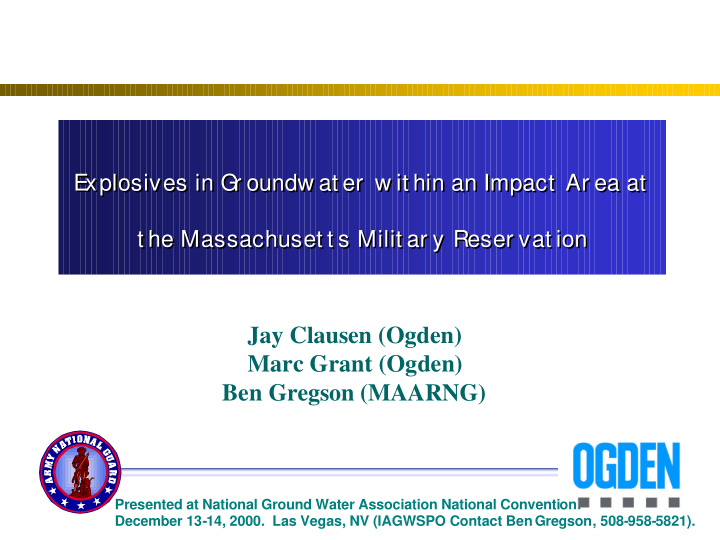



E xplosives in G r oundw at er w it hin an Impact Ar ea at E xplosives in G r oundw at er w it hin an Impact Ar ea at t he Massachuset t s Milit ar y Reser vat ion t he Massachuset t s Milit ar y Reser vat ion Jay Clausen (Ogden) Marc Grant (Ogden) Ben Gregson (MAARNG) Presented at National Ground Water Association National Convention. December 13-14, 2000. Las Vegas, NV (IAGWSPO Contact Ben Gregson, 508-958-5821).
Sit e Locat ion Sit e Locat ion Sit e Locat ion Sit e Locat ion I mpact Area Massachusetts Military Reservation
Pur pose Pur pose Has training with artillery and mortar weapon systems had an impact on groundwater at Camp Edwards (past, present, future)?
Camp E dw ar ds Hist or y Camp E dw ar ds Hist or y � Training and I mpact Areas used since 1911 � Designed to house 30,000 troops during WWI I � Records for 1989 indicate 6456 mortar practice and HE rounds and 1799 artillery practice rounds fired into the I mpact Area – munitions usage could have been 200 times higher during wartime
Camp E dw ar ds Hydr ogeologic Model Camp E dw ar ds Hydr ogeologic Model Groundwater flow is radial from a mound to the southeast of the I mpact Area in the J Range Area
Camp E dw ar ds Lit hology Camp E dw ar ds Lit hology Legend 200 ELEVATI ON I N FEET (MSL) VC Sand & 150 Gravel 100 F Sand & Silt Till 50 Bedrock Sea Level 0 Water Table -50 Well Screen -100
E xplosive Fat e- -and and- -Tr anspor t Concept ual Model Tr anspor t Concept ual Model E xplosive Fat e � Deposition of particulates to ground surface � Slow dissolution of particulates � Once in solution rapid movement through unsaturated zone leaving little residual contamination (RDX and HMX) � Rapid groundwater transport away from source
RDX Dist r ibut ion Hypot hesis RDX Dist r ibut ion Hypot hesis � Shallow surface soil detections reflect presence of solid particulates – evidence of soil concentrations in excess of RDX solubility limit � Absence of RDX in deeper soil may be the result of: – very small spatial footprint – dissolved RDX only present in wetting front – the amount of RDX residual in solution is inconsequential compared to the total volume of soil � RDX present in groundwater
Soil Result s Soil Result s Legend Non-Detect Detect I mpact Area Boundary Water-Level Contours Roads
E xplosive Dist r ibut ion in Sur f ace Soil aDNTs 26.8% NG 7.3% DNTs 4.6% NTs 2.6% TNT 2.6% RDX 33.1% H M X 22.8%
E xplosive Dist r ibut ion In G r oundw at er aD N T s 19.6% D A N T s 0.6% D N T s 3.6% N T s 2.8% R D X 46.1% T N T 3.6% H M X 23.7%
Plan View of RDX Det ect ions in t he Impact Ar ea Plan View of RDX Det ect ions in t he Impact Ar ea
Inner G r oundw at er Tr ansect w it hin t he Impact Ar ea Inner G r oundw at er Tr ansect w it hin t he Impact Ar ea 210 160 110 60 10 -40 -90
O ut er G r oundw at er Tr ansect w it hin t he Impact Ar ea O ut er G r oundw at er Tr ansect w it hin t he Impact Ar ea 210 160 110 60 10 -40 -90
Longit udinal Cr oss- -Sect ion t hr ough t he Impact Ar ea Sect ion t hr ough t he Impact Ar ea Longit udinal Cr oss 210 160 110 60 10 -40 -90
Possible Sour ce Ter ms Possible Sour ce Ter ms � High-order detonations * � Low-order detonations* � UXO * � EOD activities at the J Range � Disposal/ Burial sites � Washout
Findings Findings � RDX and HMX present in surface soil immediately adjacent targets � RDX and HMX present in groundwater downgradient of targets � TNT is largely degraded before reaching groundwater
Conclusions Conclusions � Training using artillery rounds (UXO, low/ high-order detonation, or both) appears to have resulted in an impact to groundwater � Training with mortar rounds and its impact on groundwater is pending � MMR findings are potentially applicable to other bombing ranges and battlefields
Recommend
More recommend